Programming Languages Concepts: PHP Language Development Report
VerifiedAdded on 2020/05/16
|8
|1677
|339
Report
AI Summary
This report provides a comprehensive overview of the PHP scripting language, a prominent server-side technology for web applications. It begins with an executive summary and table of contents, followed by an introduction to PHP's role in web development. The report details the language's evolution, including its origins with Rasmus Lerdorf, the time periods of development, and its domain and category. It explains PHP's motivation and intended use, along with its implementation methods, which blends compilation and interpretation. The report then explores key PHP features and constructs, illustrated with source code examples, and discusses the language's coding style. A significant portion of the report is dedicated to language evaluation, including its support for OOP characteristics and MVC architecture. Finally, the report concludes with an assessment of PHP's strengths and weaknesses and includes a list of references.
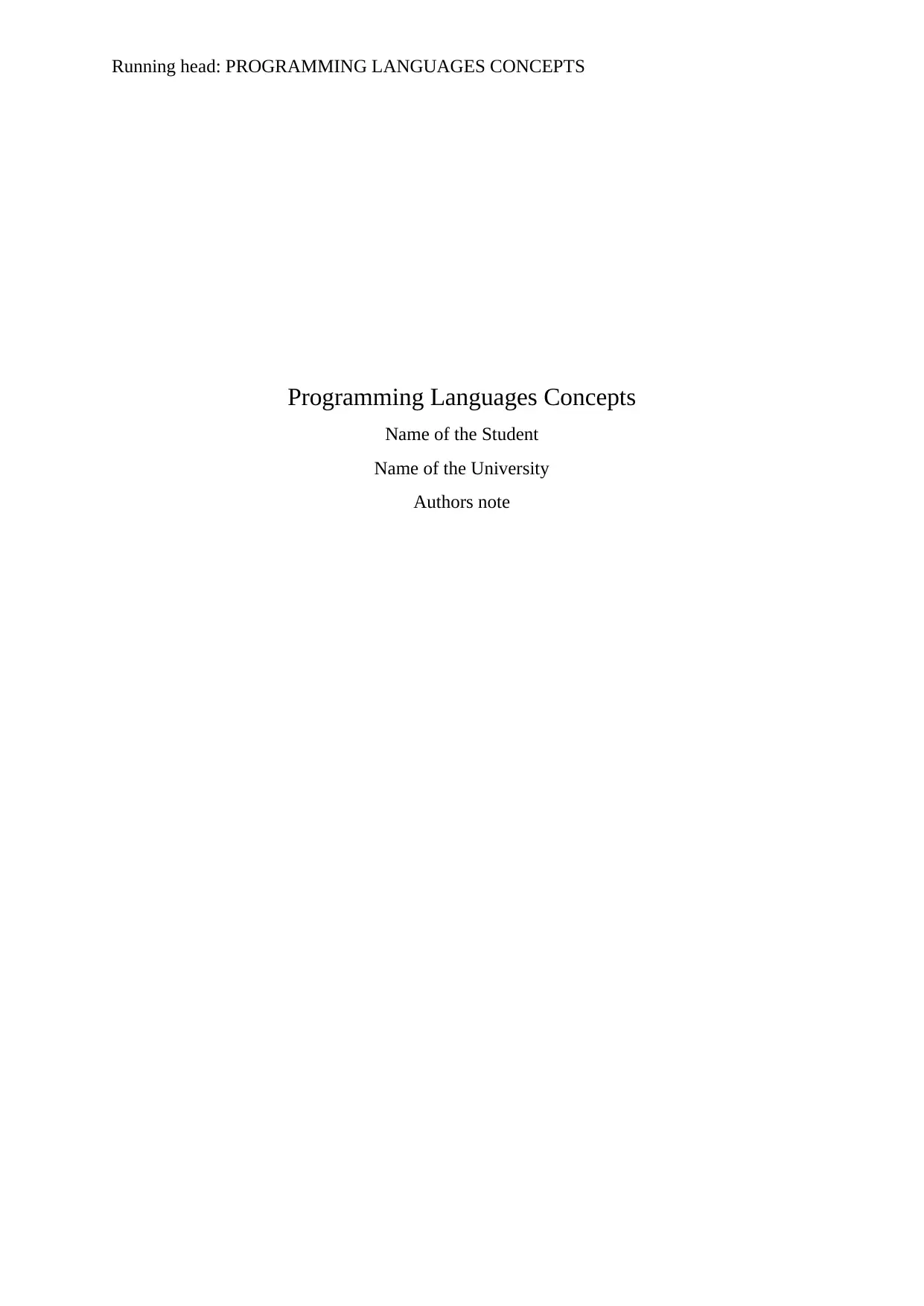
Running head: PROGRAMMING LANGUAGES CONCEPTS
Programming Languages Concepts
Name of the Student
Name of the University
Authors note
Programming Languages Concepts
Name of the Student
Name of the University
Authors note
Paraphrase This Document
Need a fresh take? Get an instant paraphrase of this document with our AI Paraphraser
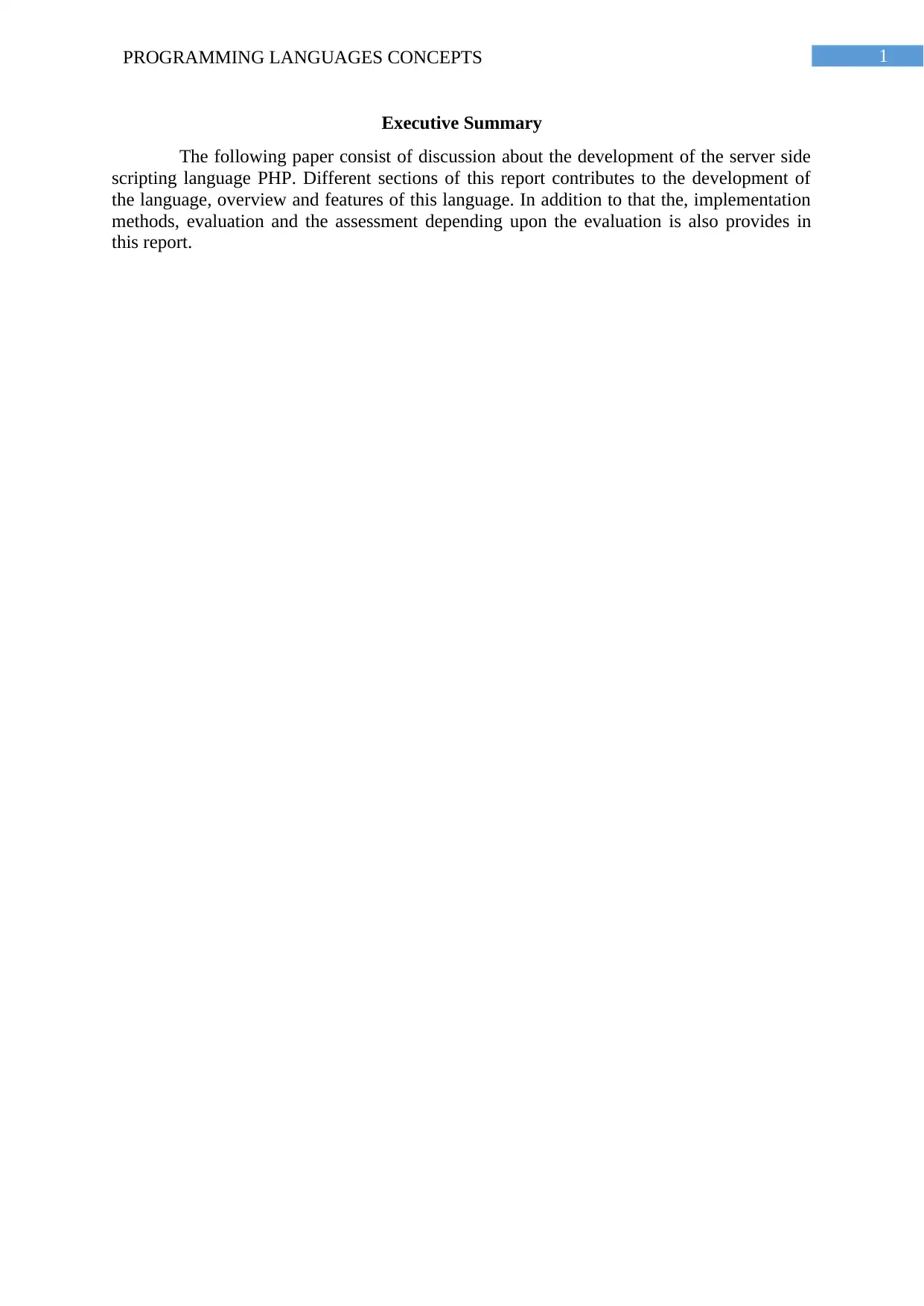
1PROGRAMMING LANGUAGES CONCEPTS
Executive Summary
The following paper consist of discussion about the development of the server side
scripting language PHP. Different sections of this report contributes to the development of
the language, overview and features of this language. In addition to that the, implementation
methods, evaluation and the assessment depending upon the evaluation is also provides in
this report.
Executive Summary
The following paper consist of discussion about the development of the server side
scripting language PHP. Different sections of this report contributes to the development of
the language, overview and features of this language. In addition to that the, implementation
methods, evaluation and the assessment depending upon the evaluation is also provides in
this report.

2PROGRAMMING LANGUAGES CONCEPTS
Table of Contents
Introduction................................................................................................................................3
Language Development.............................................................................................................3
Designer / Developer:................................................................................................3
Year or Time period:..................................................................................................3
Domain and Category:...............................................................................................4
Motivation and Intended use......................................................................................4
Language overview....................................................................................................................5
Implementation method:............................................................................................5
Features and constructs that characterize the language:............................................5
Constructs:..................................................................................................................5
Source code examples demonstrating such features and the general programming:.6
Style of the language:.................................................................................................7
Language Evaluation..................................................................................................................7
Consistent support to the different OOP characteristics............................................7
Support to the MVC architecture for applications.....................................................8
Language Assessment................................................................................................................9
Conclusion................................................................................................................................10
References................................................................................................................................11
Table of Contents
Introduction................................................................................................................................3
Language Development.............................................................................................................3
Designer / Developer:................................................................................................3
Year or Time period:..................................................................................................3
Domain and Category:...............................................................................................4
Motivation and Intended use......................................................................................4
Language overview....................................................................................................................5
Implementation method:............................................................................................5
Features and constructs that characterize the language:............................................5
Constructs:..................................................................................................................5
Source code examples demonstrating such features and the general programming:.6
Style of the language:.................................................................................................7
Language Evaluation..................................................................................................................7
Consistent support to the different OOP characteristics............................................7
Support to the MVC architecture for applications.....................................................8
Language Assessment................................................................................................................9
Conclusion................................................................................................................................10
References................................................................................................................................11
⊘ This is a preview!⊘
Do you want full access?
Subscribe today to unlock all pages.

Trusted by 1+ million students worldwide
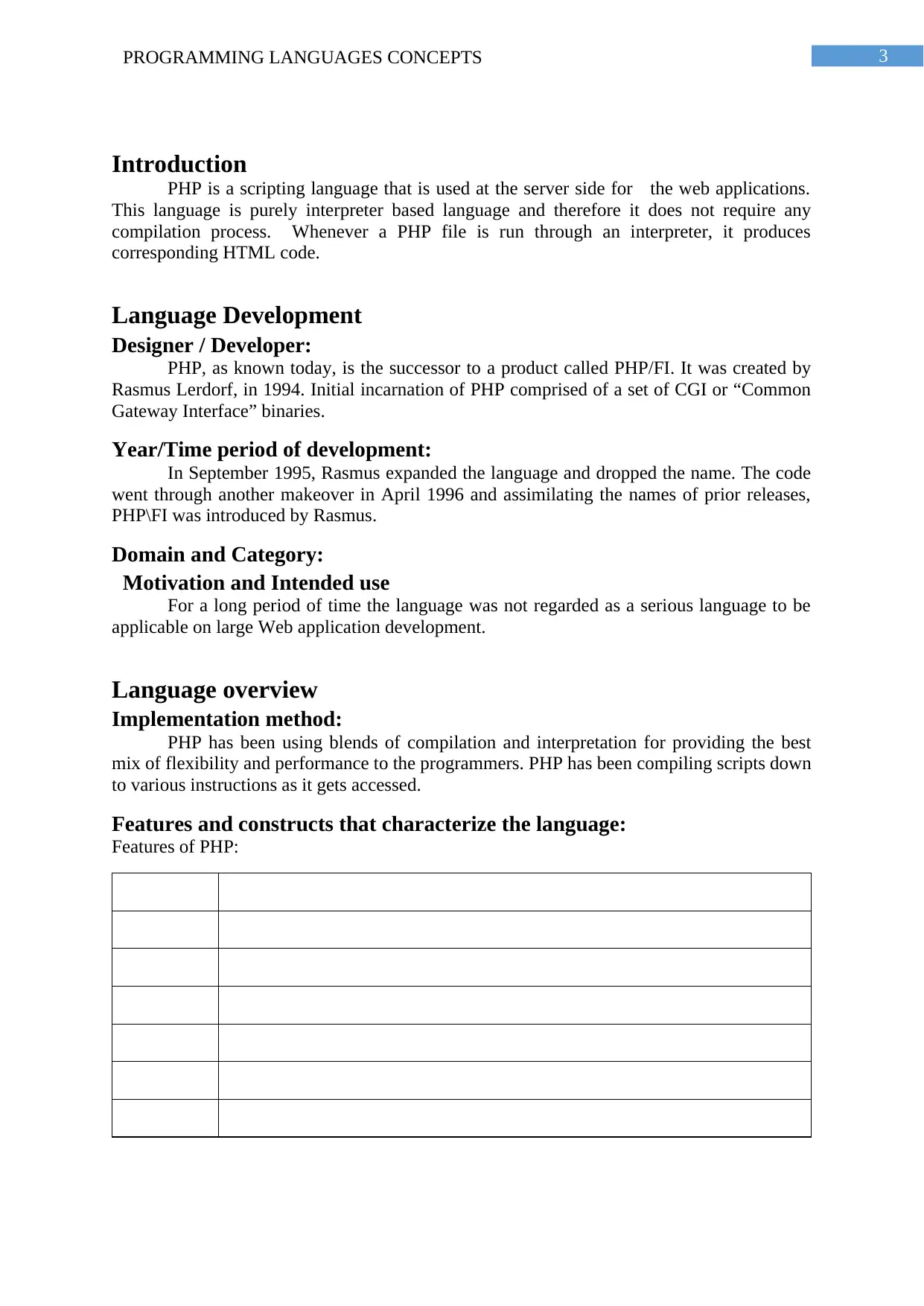
3PROGRAMMING LANGUAGES CONCEPTS
Introduction
PHP is a scripting language that is used at the server side for the web applications.
This language is purely interpreter based language and therefore it does not require any
compilation process. Whenever a PHP file is run through an interpreter, it produces
corresponding HTML code.
Language Development
Designer / Developer:
PHP, as known today, is the successor to a product called PHP/FI. It was created by
Rasmus Lerdorf, in 1994. Initial incarnation of PHP comprised of a set of CGI or “Common
Gateway Interface” binaries.
Year/Time period of development:
In September 1995, Rasmus expanded the language and dropped the name. The code
went through another makeover in April 1996 and assimilating the names of prior releases,
PHP\FI was introduced by Rasmus.
Domain and Category:
Motivation and Intended use
For a long period of time the language was not regarded as a serious language to be
applicable on large Web application development.
Language overview
Implementation method:
PHP has been using blends of compilation and interpretation for providing the best
mix of flexibility and performance to the programmers. PHP has been compiling scripts down
to various instructions as it gets accessed.
Features and constructs that characterize the language:
Features of PHP:
Introduction
PHP is a scripting language that is used at the server side for the web applications.
This language is purely interpreter based language and therefore it does not require any
compilation process. Whenever a PHP file is run through an interpreter, it produces
corresponding HTML code.
Language Development
Designer / Developer:
PHP, as known today, is the successor to a product called PHP/FI. It was created by
Rasmus Lerdorf, in 1994. Initial incarnation of PHP comprised of a set of CGI or “Common
Gateway Interface” binaries.
Year/Time period of development:
In September 1995, Rasmus expanded the language and dropped the name. The code
went through another makeover in April 1996 and assimilating the names of prior releases,
PHP\FI was introduced by Rasmus.
Domain and Category:
Motivation and Intended use
For a long period of time the language was not regarded as a serious language to be
applicable on large Web application development.
Language overview
Implementation method:
PHP has been using blends of compilation and interpretation for providing the best
mix of flexibility and performance to the programmers. PHP has been compiling scripts down
to various instructions as it gets accessed.
Features and constructs that characterize the language:
Features of PHP:
Paraphrase This Document
Need a fresh take? Get an instant paraphrase of this document with our AI Paraphraser
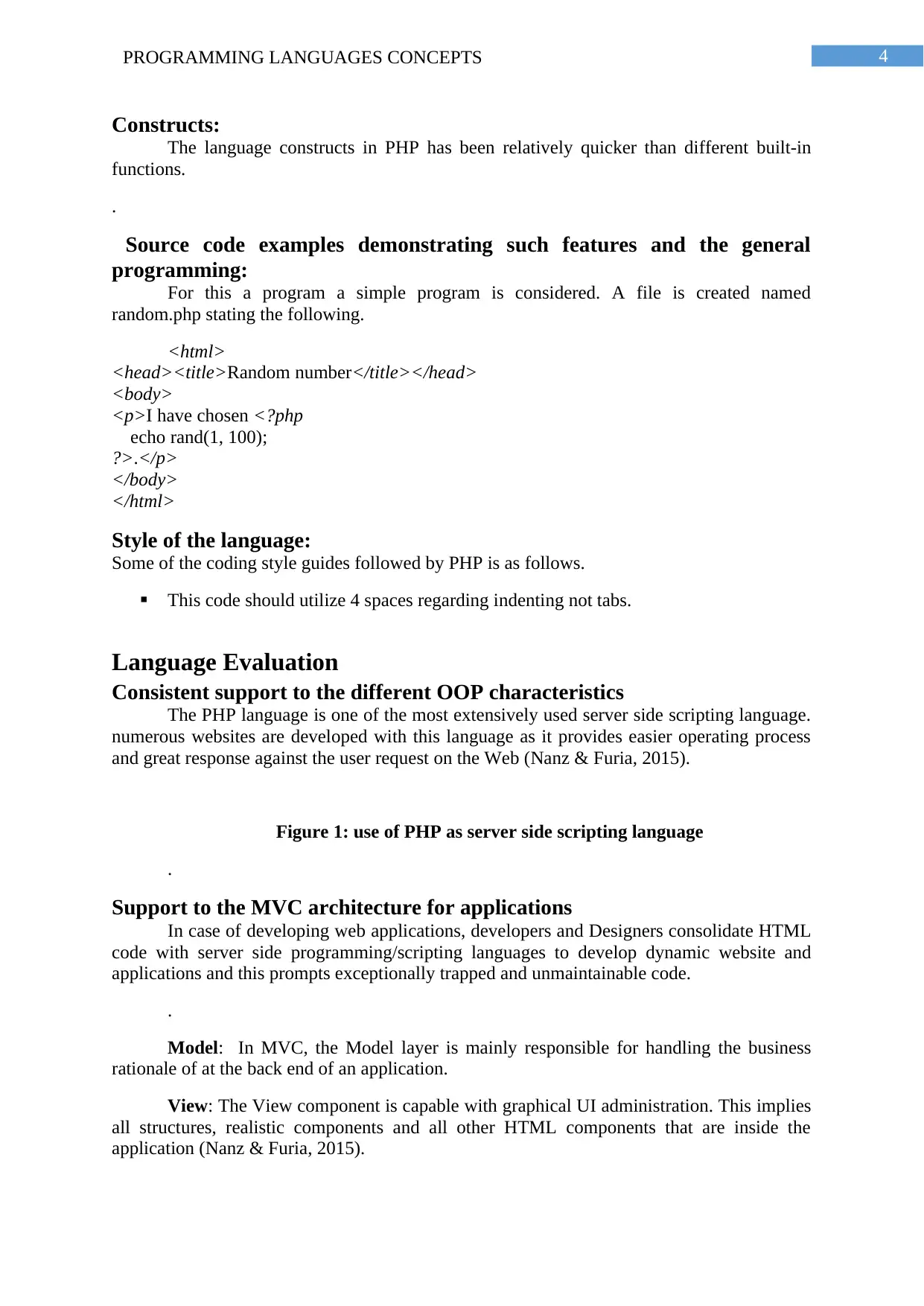
4PROGRAMMING LANGUAGES CONCEPTS
Constructs:
The language constructs in PHP has been relatively quicker than different built-in
functions.
.
Source code examples demonstrating such features and the general
programming:
For this a program a simple program is considered. A file is created named
random.php stating the following.
<html>
<head><title>Random number</title></head>
<body>
<p>I have chosen <?php
echo rand(1, 100);
?>.</p>
</body>
</html>
Style of the language:
Some of the coding style guides followed by PHP is as follows.
This code should utilize 4 spaces regarding indenting not tabs.
Language Evaluation
Consistent support to the different OOP characteristics
The PHP language is one of the most extensively used server side scripting language.
numerous websites are developed with this language as it provides easier operating process
and great response against the user request on the Web (Nanz & Furia, 2015).
Figure 1: use of PHP as server side scripting language
.
Support to the MVC architecture for applications
In case of developing web applications, developers and Designers consolidate HTML
code with server side programming/scripting languages to develop dynamic website and
applications and this prompts exceptionally trapped and unmaintainable code.
.
Model: In MVC, the Model layer is mainly responsible for handling the business
rationale of at the back end of an application.
View: The View component is capable with graphical UI administration. This implies
all structures, realistic components and all other HTML components that are inside the
application (Nanz & Furia, 2015).
Constructs:
The language constructs in PHP has been relatively quicker than different built-in
functions.
.
Source code examples demonstrating such features and the general
programming:
For this a program a simple program is considered. A file is created named
random.php stating the following.
<html>
<head><title>Random number</title></head>
<body>
<p>I have chosen <?php
echo rand(1, 100);
?>.</p>
</body>
</html>
Style of the language:
Some of the coding style guides followed by PHP is as follows.
This code should utilize 4 spaces regarding indenting not tabs.
Language Evaluation
Consistent support to the different OOP characteristics
The PHP language is one of the most extensively used server side scripting language.
numerous websites are developed with this language as it provides easier operating process
and great response against the user request on the Web (Nanz & Furia, 2015).
Figure 1: use of PHP as server side scripting language
.
Support to the MVC architecture for applications
In case of developing web applications, developers and Designers consolidate HTML
code with server side programming/scripting languages to develop dynamic website and
applications and this prompts exceptionally trapped and unmaintainable code.
.
Model: In MVC, the Model layer is mainly responsible for handling the business
rationale of at the back end of an application.
View: The View component is capable with graphical UI administration. This implies
all structures, realistic components and all other HTML components that are inside the
application (Nanz & Furia, 2015).
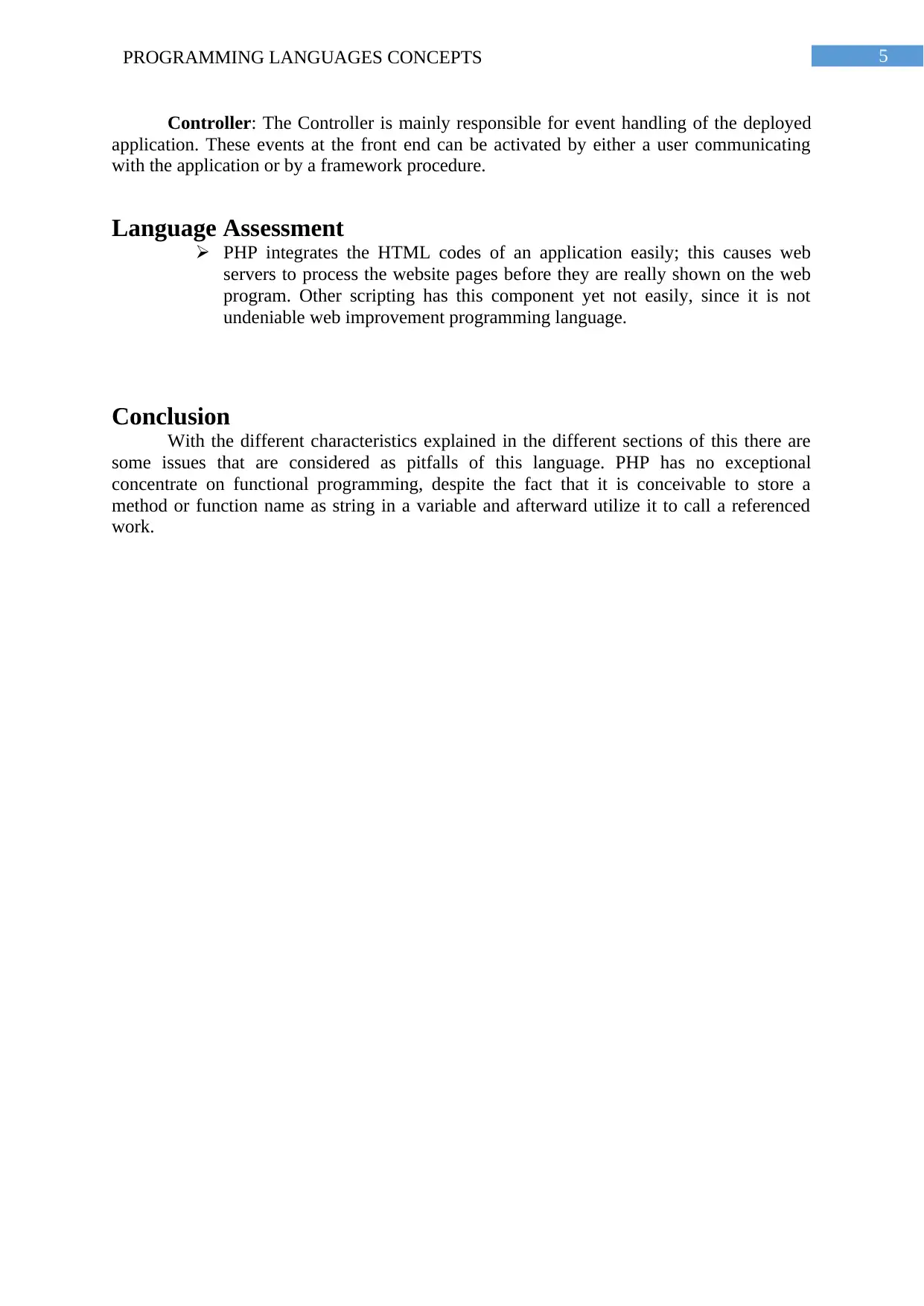
5PROGRAMMING LANGUAGES CONCEPTS
Controller: The Controller is mainly responsible for event handling of the deployed
application. These events at the front end can be activated by either a user communicating
with the application or by a framework procedure.
Language Assessment
PHP integrates the HTML codes of an application easily; this causes web
servers to process the website pages before they are really shown on the web
program. Other scripting has this component yet not easily, since it is not
undeniable web improvement programming language.
Conclusion
With the different characteristics explained in the different sections of this there are
some issues that are considered as pitfalls of this language. PHP has no exceptional
concentrate on functional programming, despite the fact that it is conceivable to store a
method or function name as string in a variable and afterward utilize it to call a referenced
work.
Controller: The Controller is mainly responsible for event handling of the deployed
application. These events at the front end can be activated by either a user communicating
with the application or by a framework procedure.
Language Assessment
PHP integrates the HTML codes of an application easily; this causes web
servers to process the website pages before they are really shown on the web
program. Other scripting has this component yet not easily, since it is not
undeniable web improvement programming language.
Conclusion
With the different characteristics explained in the different sections of this there are
some issues that are considered as pitfalls of this language. PHP has no exceptional
concentrate on functional programming, despite the fact that it is conceivable to store a
method or function name as string in a variable and afterward utilize it to call a referenced
work.
⊘ This is a preview!⊘
Do you want full access?
Subscribe today to unlock all pages.

Trusted by 1+ million students worldwide

6PROGRAMMING LANGUAGES CONCEPTS
References
Ammon, U. (2012). Linguistic inequality and its effects on participation in scientific
discourse and on global knowledge accumulation–With a closer look at the problems
of the second-rank language communities. Applied Linguistics Review, 3(2), 333-
355.
Bakker, R., Tiesinga, P., & Kötter, R. (2015). The Scalable Brain Atlas: instant web-based
access to public brain atlases and related content. Neuroinformatics, 13(3), 353-366.
Bashir, G. M. M., Hoque, A. S. M. L., & Nath, B. C. D. (2016). E-learning of PHP based on
the solutions of real-life problems. Journal of Computers in Education, 3(1), 105-129.
Brooks, D. R. (2017). PHP from a Command Line. In Programming in HTML and PHP (pp.
231-236). Springer, Cham.
Dahse, J., & Holz, T. (2014, February). Simulation of Built-in PHP Features for Precise
Static Code Analysis. In NDSS.
Hills, M. (2015, October). Supporting PHP dynamic analysis in PHP AiR. In Proceedings of
the 13th International Workshop on Dynamic Analysis (pp. 37-38). ACM.
Hu, Y. (2016). Design and Implementation of Recruitment Management System Based on
Analysis of Advantages and Disadvantages of PHP Three-Tier. Romanian Review
Precision Mechanics, Optics & Mechatronics, (49), 74.
Lei, K., Ma, Y., & Tan, Z. (2014, December). Performance comparison and evaluation of
web development technologies in php, python, and node. js. In Computational
Science and Engineering (CSE), 2014 IEEE 17th International Conference on (pp.
661-668). IEEE.
Nanz, S., & Furia, C. A. (2015, May). A comparative study of programming languages in
Rosetta Code. In Software Engineering (ICSE), 2015 IEEE/ACM 37th IEEE
International Conference on (Vol. 1, pp. 778-788). IEEE.
Nguyen, H. V., Kästner, C., & Nguyen, T. N. (2014, November). Building call graphs for
embedded client-side code in dynamic web applications. In Proceedings of the 22nd
ACM SIGSOFT International Symposium on Foundations of Software
Engineering (pp. 518-529). ACM.
Nguyen, H. V., Kästner, C., & Nguyen, T. N. (2015, May). Varis: IDE support for embedded
client code in PHP web applications. In Proceedings of the 37th International
Conference on Software Engineering-Volume 2 (pp. 693-696). IEEE Press.
Prokhorenko, V., Choo, K. K. R., & Ashman, H. (2016). Context-oriented web application
protection model. Applied Mathematics and Computation, 285, 59-78.
SEHGAL, R. (2017). Tracing Cyber Threats (Doctoral dissertation, INDIAN INSTITUTE
OF TECHNOLOGY, KANPUR).
Suzumura, T., Trent, S., Tatsubori, M., Tozawa, A., & Onodera, T. (2008, September).
Performance comparison of web service engines in php, java and c. In Web Services,
2008. ICWS'08. IEEE International Conference on (pp. 385-392). IEEE.
References
Ammon, U. (2012). Linguistic inequality and its effects on participation in scientific
discourse and on global knowledge accumulation–With a closer look at the problems
of the second-rank language communities. Applied Linguistics Review, 3(2), 333-
355.
Bakker, R., Tiesinga, P., & Kötter, R. (2015). The Scalable Brain Atlas: instant web-based
access to public brain atlases and related content. Neuroinformatics, 13(3), 353-366.
Bashir, G. M. M., Hoque, A. S. M. L., & Nath, B. C. D. (2016). E-learning of PHP based on
the solutions of real-life problems. Journal of Computers in Education, 3(1), 105-129.
Brooks, D. R. (2017). PHP from a Command Line. In Programming in HTML and PHP (pp.
231-236). Springer, Cham.
Dahse, J., & Holz, T. (2014, February). Simulation of Built-in PHP Features for Precise
Static Code Analysis. In NDSS.
Hills, M. (2015, October). Supporting PHP dynamic analysis in PHP AiR. In Proceedings of
the 13th International Workshop on Dynamic Analysis (pp. 37-38). ACM.
Hu, Y. (2016). Design and Implementation of Recruitment Management System Based on
Analysis of Advantages and Disadvantages of PHP Three-Tier. Romanian Review
Precision Mechanics, Optics & Mechatronics, (49), 74.
Lei, K., Ma, Y., & Tan, Z. (2014, December). Performance comparison and evaluation of
web development technologies in php, python, and node. js. In Computational
Science and Engineering (CSE), 2014 IEEE 17th International Conference on (pp.
661-668). IEEE.
Nanz, S., & Furia, C. A. (2015, May). A comparative study of programming languages in
Rosetta Code. In Software Engineering (ICSE), 2015 IEEE/ACM 37th IEEE
International Conference on (Vol. 1, pp. 778-788). IEEE.
Nguyen, H. V., Kästner, C., & Nguyen, T. N. (2014, November). Building call graphs for
embedded client-side code in dynamic web applications. In Proceedings of the 22nd
ACM SIGSOFT International Symposium on Foundations of Software
Engineering (pp. 518-529). ACM.
Nguyen, H. V., Kästner, C., & Nguyen, T. N. (2015, May). Varis: IDE support for embedded
client code in PHP web applications. In Proceedings of the 37th International
Conference on Software Engineering-Volume 2 (pp. 693-696). IEEE Press.
Prokhorenko, V., Choo, K. K. R., & Ashman, H. (2016). Context-oriented web application
protection model. Applied Mathematics and Computation, 285, 59-78.
SEHGAL, R. (2017). Tracing Cyber Threats (Doctoral dissertation, INDIAN INSTITUTE
OF TECHNOLOGY, KANPUR).
Suzumura, T., Trent, S., Tatsubori, M., Tozawa, A., & Onodera, T. (2008, September).
Performance comparison of web service engines in php, java and c. In Web Services,
2008. ICWS'08. IEEE International Conference on (pp. 385-392). IEEE.
Paraphrase This Document
Need a fresh take? Get an instant paraphrase of this document with our AI Paraphraser

7PROGRAMMING LANGUAGES CONCEPTS
Taricco, G. P. (2015). PHP-HTML for a customizable edit form.
Titchkosky, L., Arlitt, M., & Williamson, C. (2003). A performance comparison of dynamic
Web technologies. ACM SIGMETRICS Performance Evaluation Review, 31(3), 2-11.
Trent, S., Tatsubori, M., Suzumura, T., Tozawa, A., & Onodera, T. (2008, December).
Performance comparison of PHP and JSP as server-side scripting languages.
In Proceedings of the 9th ACM/IFIP/USENIX International Conference on
Middleware (pp. 164-182). Springer-Verlag New York, Inc..
Walia, E. S., & Gill, E. S. K. (2014). A framework for web based student record management
system using PHP. International Journal of Computer Science and Mobile
Computing, 3(8), 24-33.
Weißer, D., Dahse, J., & Holz, T. (2015, November). Security Analysis of PHP Bytecode
Protection Mechanisms. In International Workshop on Recent Advances in Intrusion
Detection (pp. 493-514). Springer, Cham.
Wyke, R. A., Walker, M. J., & Cox, R. (2016). PHP developer's dictionary.
Taricco, G. P. (2015). PHP-HTML for a customizable edit form.
Titchkosky, L., Arlitt, M., & Williamson, C. (2003). A performance comparison of dynamic
Web technologies. ACM SIGMETRICS Performance Evaluation Review, 31(3), 2-11.
Trent, S., Tatsubori, M., Suzumura, T., Tozawa, A., & Onodera, T. (2008, December).
Performance comparison of PHP and JSP as server-side scripting languages.
In Proceedings of the 9th ACM/IFIP/USENIX International Conference on
Middleware (pp. 164-182). Springer-Verlag New York, Inc..
Walia, E. S., & Gill, E. S. K. (2014). A framework for web based student record management
system using PHP. International Journal of Computer Science and Mobile
Computing, 3(8), 24-33.
Weißer, D., Dahse, J., & Holz, T. (2015, November). Security Analysis of PHP Bytecode
Protection Mechanisms. In International Workshop on Recent Advances in Intrusion
Detection (pp. 493-514). Springer, Cham.
Wyke, R. A., Walker, M. J., & Cox, R. (2016). PHP developer's dictionary.
1 out of 8
Related Documents
Your All-in-One AI-Powered Toolkit for Academic Success.
+13062052269
info@desklib.com
Available 24*7 on WhatsApp / Email
![[object Object]](/_next/static/media/star-bottom.7253800d.svg)
Unlock your academic potential
Copyright © 2020–2025 A2Z Services. All Rights Reserved. Developed and managed by ZUCOL.



